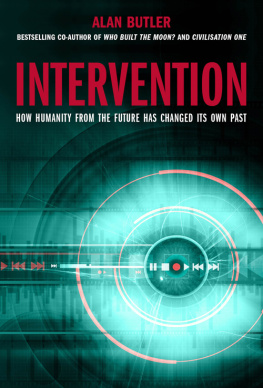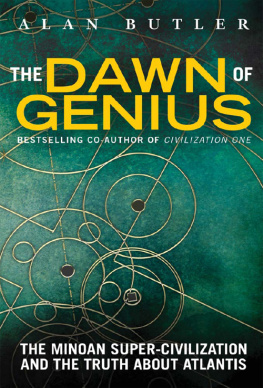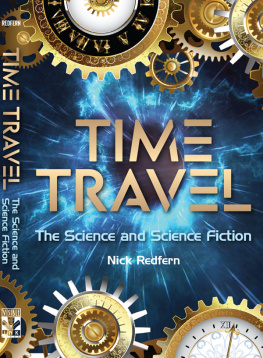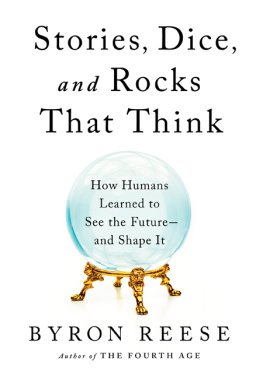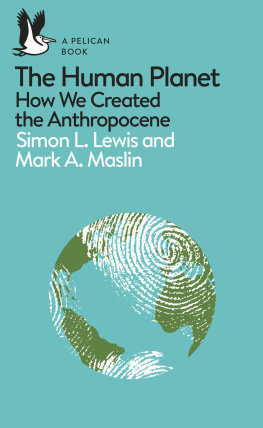Alan Butler qualified as an engineer, but has spent the last 30 years immersed in the history of the world and developing an expertise in ancient cosmology and astronomy. He has written many books, the majority of which delve in the recesses of the past that often remain ignored. Under his own name he has published books such as The Virgin and the Pentacle, Sheep, and How to Read Prehistoric Monuments. Together with Christopher Knight he has coauthored four books, and other co-operative ventures include the acclaimed Rosslyn Revealed with John Ritchie.
In addition to writing books Alan is also an accomplished playwright and has created many plays for the stage and a number for national radio. He lives on the North Yorkshire coast of England with his wife Kate and, when not pounding away at the computer or travelling, he is to be found in his workshop, building musical instruments or tinkering with his ancient sports car.
Also by Alan Butler
The Bronze Age Computer Disc
The Warriors and the Bankers
The Templar Continuum
The Goddess, the Grail and the Lodge
City of the Goddess
How to Read Prehistoric Monuments
With Christopher Knight
Civilization One
Who Built the Moon?
The Hiram Key Revisited
Before the Pyramids
INTERVENTION
How humanity from the future has changed its own past
Alan Butler

This book is dedicated to the memory of Dr John Snow (181358), who followed Sherlock Holmes most famous advice, even though it had not yet been written.
* * *
This edition first published in the UK 2012 by Watkins Publishing, Sixth Floor, Castle House, 7576 Wells Street, London W1T 3QH
Design and typography copyright Watkins Publishing 2012 Text Copyright Alan Butler 2012
Alan Butler has asserted his right under the Copyright, Designs and Patents Act 1988 to be identified as the author of this work.
All rights reserved.
No part of this book may be reproduced or utilized in any form or by any means, electronic or mechanical, without prior permission in writing from the Publishers.
1 3 5 7 9 10 8 6 4 2
Designed and typeset by Jerry Goldie
Printed and bound in China by Imago
British Library Cataloguing-in-Publication Data Available
ISBN: 978-1-78028-425-5
www.watkinspublishing.co.uk
Contents
Acknowledgments
As always my heartfelt thanks go to my wife Kate, who helps, encourages and often even believes.
Im always in debt to Michael Mann, who is much more than a publisher, and finally I offer a special award to my editor Shelagh Boyd, who has the knack of making a chore into a pleasure.
Introduction
G rowing up as I did in the 1960s and 1970s, I was introduced to a raft of information that had become extremely popular at that time. The genre was heralded by the arrival of an author called Erich von Dniken. In 1968 Erich von Dniken published a book entitled Chariots of the Gods. The startling claims in this book made headlines across the world at the time, and rightfully so. He claimed that the path of humanity from its earliest emergence had been dramatically altered by the visitation to Earth of beings from other parts of the cosmos.
Whilst ordinary people flocked to read this book and the others that followed in its wake, orthodoxy was more circumspect. Von Dniken claimed there were many happenings, especially in the remote past of humanity, that could not be explained by normal means. How he wanted to know could a fairly primitive Bronze-Age culture that existed in Egypt as far back as 2500 BC have possibly built so many huge monuments? Considering the limited technical abilities of the culture, it seemed positively incredible that structures such as the Great Pyramid, which contains an estimated two and a half million blocks of stone could have been planned and completed apparently in very short periods of time. The ancient Egyptians were not alone in this regard. There are puzzles, such as the stones of Baalbek in Lebanon, where massive stone blocks, one of which weighs upward of 1,000 tonnes, were quarried and set in place at some unknown period in prehistory representing a feat of engineering that would be hard to parallel today.
Meanwhile, across the Atlantic in Central and South America, other unknown cultures also quarried huge rocks without using any metal at all. They managed to fit them together like pieces of a massive jigsaw puzzle, so accurately that after countless centuries it is still impossible to fit a penknife blade between them. They produced great citadels that have survived the many earthquakes that regularly shake these regions, whilst colonial buildings left in the same area by the Spanish have crumbled to dust.
Using these and countless other examples, Erich von Dniken made a good point. He addresses those aspects of history that a fair proportion of experts would prefer to leave alone. Clearly nobody can deny that such structures exist they remain on the landscape for anyone to see; yet when archaeology teaches us of the cultures to which these masterpieces of engineering are attributed, it seems incredible that our ancient ancestors, no matter how bright they may have been, could have had the resources, the manpower, or the incentive to manage such herculean tasks.
Erich von Dniken made what might still sound like a preposterous claim when he dared to suggest that ancient peoples had not managed many of these building feats on their own. Rather, he proposed that these societies had been infiltrated with beings that were far more advanced than humanity was at the time. Von Dniken claimed there was significant evidence that the Earth had been subjected to countless visitations of beings from other planets in the cosmos, and it was these visitors who had provided the means and also the incentive to plan and build some of the most impressive structures of the remote past.
He pointed to mythologies from around the globe, retelling stories of giants and super-beings from many different cultures, suggesting that visitations of gods or demi-gods may have been nothing of the sort. Von Dniken reproduced rock art and folk art in the form of costumes and masks, all of which seemed to speak not of mythical gods but rather of corporeal beings who had influenced many different civilizations.
Other writers looked at these puzzles, but came to different conclusions. Some pointed to the stories of Atlantis, the lost civilization first written about by Plato, who claimed that Atlantis had been a great island that was to be found in the Atlantic, far beyond the Pillars of Hercules. Platos Atlantis was in many ways the ideal civilization, but it had eventually grown corrupt and, because the gods came to despise it, the island was swallowed up in a series of earthquakes and volcanoes. Modern writers asked if Plato had been responding to much earlier sources and wondered if Atlantis, or some place like it, had actually existed long before the civilizations we do know about rose to greatness. Perhaps the influence of some now virtually unknown, forgotten culture was responsible for the apparent miracles from prehistory?
Faced with a deluge of interest in such matters, experts responded, pointing out obvious mistakes made by Erich von Dniken and other speculative writers of a similar sort. By so doing they sought to recapture history for orthodoxy. In the main it did not work, and the truth is that there is much from the ancient past of humanity that still makes very little sense, at least in terms of the explanations trotted out by historians. To suggest that all the questions Erich von Dniken and others of his kind were asking are irrelevant, simply because a few of von Dnikens supposed solutions have been tested and found wanting, is not reasonable and is a classic case of throwing out the baby with the bath water.

